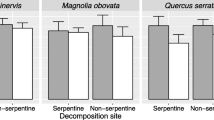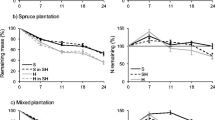Abstract
Silvopastoral management strategies seek to expand spatial and temporal boundaries of forage production and promote ecosystem integrity through a combination of tree thinning and understory pastures. We determined the effects of water extracts of leaf litter from three species of overstory hardwood trees, yellow poplar, red maple, and white oak, on germination of common forage species: alfalfa, red and white clover, crabgrass, orchardgrass, and tall fescue without and with endophytes to increase understanding about potential interactions between silvopastures and overstory deciduous trees. Litter extracts reduced germination in red and white clover in a concentration dependent manner with greatest effects observed for poplar > maple > oak extracts. These reductions were linearly related to increasing osmolality and electrical conductivity of the leaf extracts. Modified Gompertz growth curve models, fit to data, further indicated treatment with litter extracts, especially poplar, delayed and slowed germination. Similarly, cumulative germination of a variety of grasses was inhibited by filtered 6 % (w/v) litter extracts with the effects of poplar > maple > oak. However, germination of all forages resumed after rinsing extract-treated seeds with water indicating inhibition could be due, in part, to osmotic effects of extracts or water-soluble allelopathic compounds. Final germination varied with forage species and extract type, but in most instances, did not reach the level of the control further suggesting specific ion toxicities as well. Management practices that account for the interactions between trees and forages are needed to ensure successful establishment and persistence of mixed species swards in silvopastoral systems.





Similar content being viewed by others
References
Alley J, Garrett H, McGraw R, Dwyer J, Blanche C (1998) Forage legumes as living mulches for trees in agroforestry practices-preliminary results. Agroforest Syst 44:281–291
Almansouri M, Kinet JM, Lutts S (2001) Effect of salt and osmotic stresses on germination in durum wheat (Triticum durum Desf.). Plant Soil 231:243–254
Asci OO (2013) Salt tolerance in red clover (Trifolium pratense L.) seedlings. Afr J Biotechnol 10:8774–8781
Ashagre H, Hamza I, Fasika E, Temesgen F (2013) Effect of salinity stress on germination and seedling vigour of chickpea (Cicer arietinum L.) cultivars. Acad J Ag Res 1:161–166
Atangana A, Khasa D, Chang S, Degrande A (2014) Ecological interactions and productivity in agroforestry systems. Tropical Agroforestry. Springer, Netherlands, pp 151–172
Belesky DP (2005) Growth of Dactylis glomerata along a light gradient in the central Appalachian region of the eastern USA: I. Dry matter production and partitioning. Agroforest Syst 65:81–90
Belesky DP, Chatterton NJ, Neel JPS (2006) Dactylis glomerata growing along a light gradient in the central Appalachian region of the eastern USA: III. nonstructural carbohydrates and nutritive value. Agroforest Syst 67:51–61
Belesky DP, Ruckle JM, Bush LP (2009) Microsite conditions influence nutritive value characteristics of a tall fescue cultivar devoid of, or infected with a native, or a novel non-ergogenic endophyte. Environ Exp Bot 67:284–292
Bewley JD (1997) Seed germination and dormancy. Plant Cell 9:1055–1066
Bradford KJ (1990) A water relations analysis of seed germination rates. Plant Physiol 94:840–849
Bradford KJ (1995) Water relations in seed germination. In: Kigal J, Galili G (eds) Seed development and germination. Marcel Dekker, New York, pp 351–396
Chiapusio G, Sánchez AM, Reigosa MJ, González L, Pellissier F (1997) Do germination indices adequately reflect allelochemical effects on the germination process? J Chem Ecol 23:2445–2453
Chon S-U, Nelson CJ (2013) Allelopathic dynamics in resource plants. In: Cheema ZA, Farooq M, Wahid A (eds) Allelopathy. Springer, Berlin, pp 81–110
Chon S-U, Nelson CJ, Coutts JH (2004) Osmotic and autotoxic effects of leaf extracts on germination and seedling growth of alfalfa. Agron J 96:1673–1679
Chung I-M, Miller DA (1995) Allelopathic influence of nine forage grass extracts on germination and seedling growth of alfalfa. Agron J 87:767–772
Cope WA (1982) Inhibition of germination and seedling growth of eight forage species by leachates from seeds. Crop Sci 22:1109–1111
Corbett BF, Morrison JA (2012) The allelopathic potentials of the non-native invasive plant Microstegium vimineum and the native Ageratina altissima: two dominant species of the eastern forest herb layer. Northeast Nat 19:297–312
Cubbage F, Balmelli G, Bussoni A, Noellemeyer E, Pachas A, Fassola H, Colcombet L, Rossner B, Frey G, Dube F, de Silva M, Stevenson H, Hamilton J, Hubbard W (2012) Comparing silvopastoral systems and prospects in eight regions of the world. Agroforest Syst 86:303–314
de Albuquerque MB, dos Santos RC, Lima LM, de Albuquerque Melo Filho P, Nogueira RJMC, da Câmara CAG, de Rezende Ramos A (2011) Allelopathy, an alternative tool to improve cropping systems. A review. Agron Sustain Dev 31:379–395
Del Fabbro C, Güsewell S, Prati D (2014) Allelopathic effects of three plant invaders on germination of native species: a field study. Biol Invasions 16:1035–1042
Donohue K, Rubio de Casas R, Burghardt L, Kovach K, Willis CG (2010) Germination, postgermination adaptation, and species ecological ranges. Annu Rev Ecol Evol S 41:293–319
Ebrahimi E, Eslami SV (2012) Effect of environmental factors on seed germination and seedling emergence of invasive Ceratocarpus arenarius. Weed Res 52:50–59
Einhellig FA (1996) Interactions involving allelopathy in cropping systems. Agron J 88:886–893
Feldhake CM (2002) Forage frost protection potential of conifer silvopastures. Agric Forest Meteorol 112:123–130
Feldhake C, Belesky DP (2009) Photosynthetically active radiation use efficiency of Dactylis glomerata and Schedonorus phoenix along a hardwood tree-induced light gradient. Agroforest Syst 75:189–196
Feldhake CM, Neel JPS, Belesky DP (2010) Establishment and production from thinned mature deciduous-forest silvopastures in Appalachia. Agroforest Syst 79:31–37
Garrett HE, Kerley MS, Ladyman KP, Walter WD, Godsey LD, Van Sambeek JW, Brauer DK (2004) Hardwood silvopasture management in North America. Agroforest Syst 61–62:21–33
Han D, Li S, Wang E, Meng H, Chen Y, Zhang Y (2014) Effect of exogenous calcium on seed germination and seedling physiological characteristics of Lycium ruthenium. Zhongguo Zhong Yao Za Zhi 39:34–39
Hardegree SP, Emmerich WE (1990) Partitioning water potential and specific salt effects on seed germination of four grasses. Ann Bot-London 66:587–595
Houx JH III, McGraw RL, Garrett HG, Kallenbach RL, Fritschi FB, Gold MA (2012) Temperate silvopasture tree establishment and growth as influenced by forage species and cultural management practices. J Agric Sci 4:20–30
Jisha KC, Vijayakumari K, Puthur J (2013) Seed priming for abiotic stress tolerance: an overview. Acta Physiol Plant 35:1381–1396
Jose S, Gillespie AR, Pallardy SG (2004) Interspecific interactions in temperate agroforestry. Agroforest Syst 61–62:237–255
Kallenbach RL, Kerley MS, Bishop-Hurley GJ (2006) Cumulative forage production, forage quality and livestock performance from an annual ryegrass and cereal rye mixture in a pine walnut silvopasture. Agroforest Syst 66:43–53
Khan AA (1992) Preplant physiological seed conditioning. Hortic Rev 13:131–181
Lorenz K, Lal R (2014) Soil organic carbon sequestration in agroforestry systems. A review. Agron Sustain Dev 34:443–454
Manonmani V, Begum MAJ, Jayanthi M (2014) Halo priming of seeds. Res J Seed Sci 7:1–13
McGraw RL, Stamps WT, Houx JH, Linit MJ (2008) Yield, maturation, and forage quality of alfalfa in a black walnut alley-cropping practice. Agroforest Syst 74:155–161
Neumann RB, Cardon ZG (2012) The magnitude of hydraulic redistribution by plant roots: a review and synthesis of empirical and modeling studies. New Phytol 194:337–352
Nichols PGH, Malik AI, Stockdale M, Colmer TD (2009) Salt tolerance and avoidance mechanisms at germination of annual pasture legumes: importance for adaptation to saline environments. Plant Soil 315:241–255
Paramathma M, Amal JA, Rajkumar M (2000) Tree allelopathy in agroforestry. In: Narwal SS, Hoagland RE, Dilday RH, Reigosa MJ (eds) Allelopathy in ecological agriculture and forestry. Springer, Dordrecht, pp 229–235
Pavlović P, Muscolo A, Sidari M, Mitrović M (2014) Non-trophic interactions: allelopathy. In: Dighton J, Krumins JA (eds) Interactions in soil: promoting plant growth. Springer, New York, pp 139–162
Putnam AR, Duke WB (1978) Allelopathy in agroecosystems. Annu Rev Phytopathol 16:431–451
Rajjou L, Duval M, Gallardo K, Catusse J, Bally J, Job C, Job D (2012) Seed germination and vigor. Annu Rev Plant Biol 63:507–533
Redmann RE (1974) Osmotic and specific ion effects on the germination of alfalfa. Can J Botany 52:803–808
Rizvi SJH, Tahir M, Rizvi V, Kohli RK, Ansari A (1999) Allelopathic interactions in agroforestry systems. Crit Rev Plant Sci 18:773–796
SAS Institute. (2002–2008) SAS/STAT user’s guide, version 9.2. SAS Institute, Cary, NC
Sharma ML (1973) Simulation of drought and its effect on germination of five pasture species. Agron J 65:982–987
Singh HP, Batish DR, Kohli RK (2001) Allelopathy in agroecosystems. J Crop Prod 4:1–41
Tobe K, Li X, Omasa K (2002) Effects of sodium, magnesium and calcium salts on seed germination and radicle survival of a halophyte, Kalidium caspicum (Chenopodiaceae). Aust J Bot 50:163–169
Tsonkova P, Böhm C, Quinkenstein A, Freese D (2012) Ecological benefits provided by alley cropping systems for production of woody biomass in the temperate region: a review. Agroforest Syst 85:133–152
Ungar IA (1991) Ecophysiology of vascular halophytes. CRC Press, Boca Raton
Wardle DA, Nicholson KS, Ahmed M (1992) Comparison of osmotic and allelopathic effects of grass leaf extracts on grass seed germination and radicle elongation. Plant Soil 140:315–319
Young CA, Hume DE, McCulley RL (2013) Forages and Pastures Symposium: fungal endophytes of tall fescue and perennial ryegrass: pasture friend or foe? J Anim Sci 91:2379–2394
Zhang Q, Zuk A, Rue K (2013) Salinity tolerance of nine fine fescue cultivars compared to other cool-season turfgrasses. Sci Hortic-Amsterdam 159:67–71
Zwietering MH, Il Jongenburger, Rombouts FM, Van’t Riet K (1990) Modeling of the bacterial growth curve. Appl Environ Microb 56:1875–1881
Acknowledgments
The authors thank H. Godwin, M. Huffman, E. Mathias, T. Robertson, D. Ruckle and B. White for valuable assistance in collection and analysis of data. In memoriam R. B. Halvorson.
Author information
Authors and Affiliations
Corresponding author
Ethics declarations
Disclaimer
The U.S. Department of Agriculture (USDA) prohibits discrimination in all its programs and activities on the basis of race, color, national origin, age, disability, and where applicable, sex, marital status, family status, parental status, religion, sexual orientation, genetic information, political beliefs, reprisal, or because all or part of an individual’s income is derived from any public assistance program (Not all prohibited bases apply to all programs). USDA is an equal opportunity provider and employer. Mention of commercial products and organizations in this manuscript is solely to provide specific information. It does not constitute endorsement by USDA-ARS over other products and organizations not mentioned.
Electronic supplementary material
Below is the link to the electronic supplementary material.
Rights and permissions
About this article
Cite this article
Halvorson, J.J., Belesky, D.P. & West, M.S. Inhibition of forage seed germination by leaf litter extracts of overstory hardwoods used in silvopastoral systems. Agroforest Syst 91, 69–83 (2017). https://doi.org/10.1007/s10457-016-9908-0
Received:
Accepted:
Published:
Issue Date:
DOI: https://doi.org/10.1007/s10457-016-9908-0




